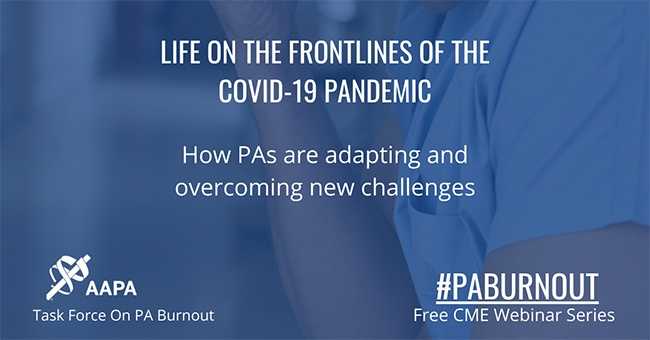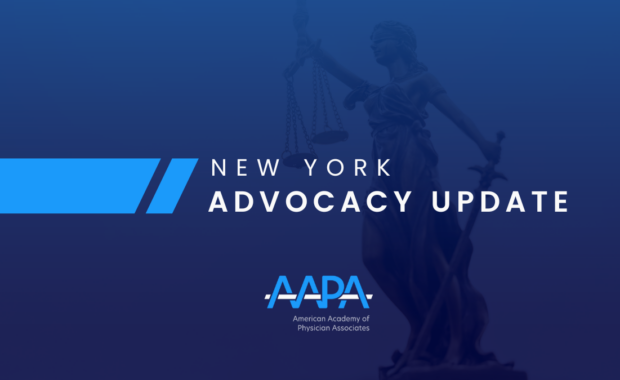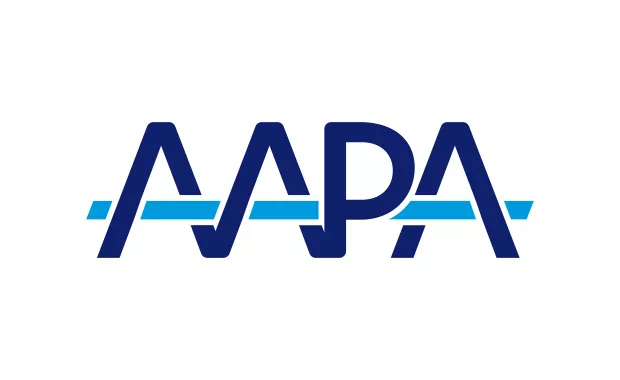AAPA Joint Task Force on Burnout Offers Burnout Resources on Website
Crisis in Healthcare for PAs Worsened by COVID-19
By Amanda Chapman, MMS, PA-C, and Barbara Morrison, PA-C

PA, PA, are you okay!?
Good morning, good afternoon, good evening. How are you genuinely doing today, my fellow PA? If you are one of the estimated 45% of PAs who were experiencing burnout (before the COVID-19 pandemic), then deep down your inner voice may be screaming, “I’m not okay!” but your automatic response is to say that you are “fine”. PA, you are not alone.1
Interpersonal disengagement, work exhaustion, cynicism, or even overall burnout may also coincide with depression, anxiety, even suicidality. These are just some of the factors that are affecting PAs’ well-being. Burnout is a crisis in healthcare, worsened by the COVID-19 pandemic.2 Medical associations and healthcare organizations are more acutely aware of burnout and the related sequalae.
AAPA understands the need to support PAs whose well-being is affected. They have started a bigger conversation and are working to establish a better understanding of PA burnout. In 2019 the Board of Directors and House of Delegates convened the AAPA Joint Task Force on Burnout (JTF). As members of the JTF, we are (1) developing and providing resources and information on PA burnout, (2) improving awareness of the signs of burnout (in colleagues or ourselves), and (3) offering strategies to mitigate the risk of burnout. In conjunction with the AAPA Research Department, we are also ramping up research into this widespread issue.
By taking initiative on burnout, AAPA is not only supporting PAs but is positioning the profession to better inform and advise institutions on ineffective practices and outdated policies related to the issue.
Burnout magnified by the COVID-19 pandemic
The U.S. healthcare system faces unprecedented challenges in patient care. As PAs, we have been exposed to unique long-term stressors and expanded roles, as have our physician peers; further increasing risk of burnout.3 An emerging body of literature reveals that similar to its high prevalence among physicians and nurses, burnout is common among PAs. 4
- Significant personal and patient care consequences are related to burnout and involve job dissatisfaction, depression, compromised safety, and decreased quality of care.4
- Neither PAs or other health care providers are immune to depression, substance abuse and suicide.4
- Everywhere, providers are leaving practice entirely or choosing administrative or other positions.4
- Changes beyond our control, acuity of those we care for, and increased administrative tasks on our plates have all spun out of control.
We are learning why we burn out. In the rush to adjust to evolving clinical guidelines, new work settings with personal and professional demands that all seem to need more from us, we can find ourselves neglecting our own self-care and losing connection with our purpose.
Prevention and Treatment:
The JTF, currently in its second year, has developed a website dedicated to PA Burnout. This curated collection of resources includes materials created by the JTF (denoted as such) as well as other resources.
On newly expanded website, clinicians and students can find:
News & communications
- Rich content from AAPA News Central is located in one place
- Webinars & Learning includes Joint Task Force developed CME on identifying burnout and strategies to reduce the symptoms, available to all PAs and students JTF
- Additional CME available through AAPA Learning Central
- A series of factsheets on burnout, moral distress, and wellbeing JTF
- Links to original research from the AAPA Research Department
- And more
AAPA Actions
External Resources
- Links to external resources including more information on well-being, burnout, and self-assessments to see where you are at the moment
As integral members of healthcare teams, PAs contribute to and benefit from interprofessional endeavors, such as the National Academy of Medicine Action Collaborative on Clinician Well-Being and Resilience, that work towards reversing trends in clinician burnout. Although these interprofessional efforts are important, the task force was created to address the specific needs of PAs.
In the coming months, we ask that PAs watch the webinars, join the dialogue on Huddle, and share our work on social media.
Facebook
Instagram
Instagram story
#Burnout.
Authors
Authors are Amanda Chapman, MMS, PA-C and Barbara Morrison, PA-C with support from Noël Smith, senior director of AAPA Research. Contact Noel at [email protected].
More Resources
AAPA Career Central: PA Burnout
Join us on the Huddle starting November 9, 2020: #burnout
Blueprint for Addressing Physician Assistant Well-being and Burnout
JAAPA Articles on Burnout
References
- Blackstone SR, Johnson AK, Smith NE, McCall TC, Simmons W, Skelly A. (Forthcoming). Depression, Burnout, and Professional Outcomes among Physician Assistants. JAAPA.
- Dewey C, Hingle S, Goelz E, Linzer M. Supporting clinicians during the COVID-19 pandemic. Ann Intern Med. [e-pub March 20, 2020]
- Essary AC, Bernard KS, Coplan B, et al. Burnout and job and career satisfaction in the physician assistant profession: a review of the literature. NAM Perspect. https://doi.org/10.31478/201812b. Accessed May 4, 2020.
- Dyrbye LN, Shanafelt TD, Sinsky CA, et al. Burnout among health care professionals: a call to explore and address this underrecognized threat to safe, high-quality care. NAM Perspect. https://doi.org/10.31478/201707b. Accessed May 4, 2020.
Thank you for reading AAPA’s News Central
You have 2 articles left this month. Create a free account to read more stories, or become a member for more access to exclusive benefits! Already have an account? Log in.



